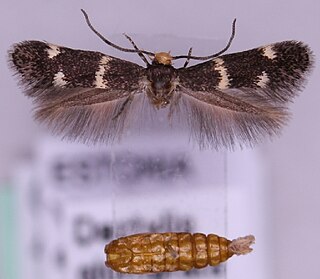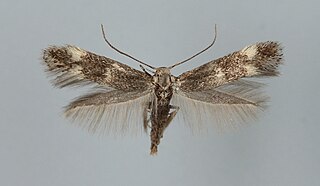
The Elachistidae are a family of small moths in the superfamily Gelechioidea. Some authors lump about 3,300 species in eight subfamilies here, but this arrangement almost certainly results in a massively paraphyletic and completely unnatural assemblage, united merely by symplesiomorphies retained from the first gelechioid moths.

Elachista luticomella is a moth of the family Elachistidae. It is found in most of Europe.

Elachista tengstromi is a moth of the family Elachistidae found in Europe and Japan. The moth was formerly considered to be a form of Elachista regificella.

Elachista eleochariella is a moth of the family Elachistidae found in Europe and North America.

Elachista albidella is a moth of the family Elachistidae, described by William Nylander in 1848. Its wingspan ranges from 9–10 millimetres (0.35–0.39 in).The head is white. Forewings are white, costa and sometimes dorsum suffused with fuscous; plical stigma large, elongate, black ; an angulated fuscous fascia beyond middle, angle acutely produced towards apex ; small fuscous costal and dorsal spots near apex. Hindwings are rather dark grey.The larva is greenish-grey, more yellowish anteriorly; head dark brown.

Elachista nobilella is a moth of the family Elachistidae found in Europe.

Elachista eskoi is a moth of the family Elachistidae. It is found in Great Britain, Denmark, Fennoscandia and the Baltic region.

Elachista pomerana is a moth of the family Elachistidae found in Europe.

Elachista is a genus of gelechioid moths described by Georg Friedrich Treitschke in 1833. It is the type genus of the grass-miner moth family (Elachistidae). This family is sometimes circumscribed very loosely, including for example the Agonoxenidae and Ethmiidae which seem to be quite distinct among the Gelechioidea, as well as other lineages which are widely held to be closer to Oecophora than to Elachista and are thus placed in the concealer moth family Oecophoridae here.
Elachista saarelai is a moth of the family Elachistidae that is endemic to southern Finland.
Elachista tanaella is a moth of the family Elachistidae. It is only known from northern Norway.

Elachista geminatella is a moth of the family Elachistidae found in Europe.
Elachista vanderwolfi is a moth of the family Elachistidae that is found in Spain, France and Austria.

Elachista titanella is a moth of the family Elachistidae. It is found in the central Caucasus Mountains in Russia.
Elachista wieseriella is a moth of the family Elachistidae which is endemic to Austria.
”Elachista” parvipulvella is a moth of the superfamily Gelechioidea. It was described from Texas.
Elachista crocogastra is a moth of the family Elachistidae. It is found in Madagascar and South Africa.
Elachista celegormella is a moth of the family Elachistidae. It is found in the United States, where it has been recorded from California.
Elachista saccharella, the sugarcane leafminer moth, is a moth of the family Elachistidae. It is found in Florida, and Louisiana in the United States and in Cuba.
Elachista jubarella is a moth species in the family Elachistidae. It was described by Lauri Kaila in 2011. It is found in Russia, where it has been recorded from the western Caucasus. The habitat consists of alpine meadows.










